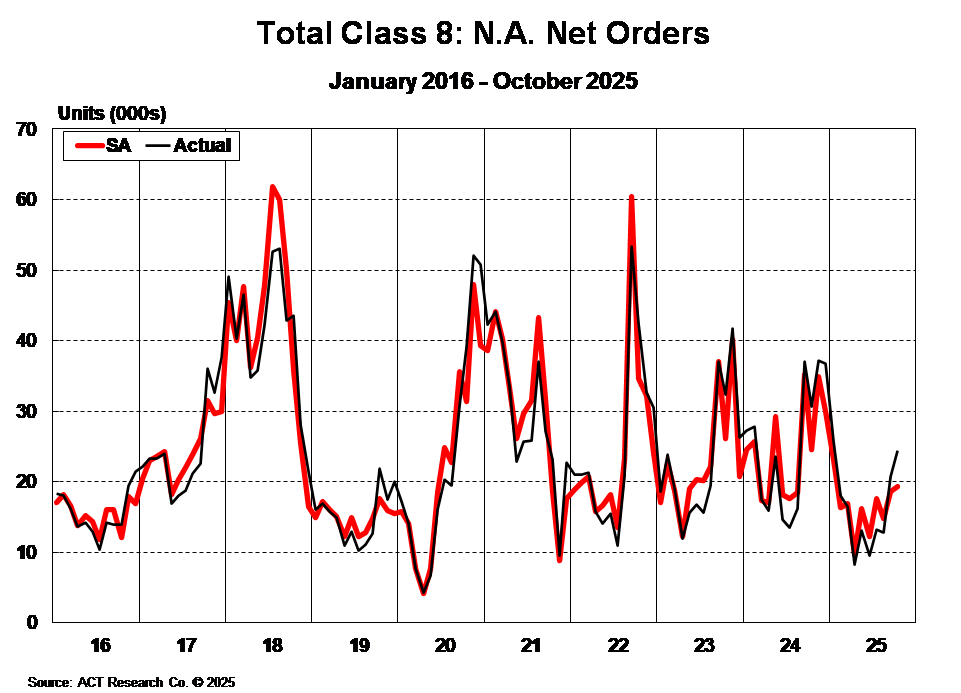
Shippers
See the Future of Freight
Anticipate market cycles with confidence. Trusted by shippers who demand more than guesswork, forward-looking insights keep you informed, agile, and ahead.
Get A PDF Preview: US, Canada, and Cross-Boarder Rate & VolumeStill reacting instead of planning ahead?
You’re not alone. Many logistics leaders are blindsided by market volatility, stuck reacting while crucial budget dollars vanish. Is this you?
Sudden Rate Spikes?
Your budget hammered by unexpected increases, leaving you scrambling.
Capacity Crashes?
Struggling to secure freight because you couldn't see the crunch coming.
Spreadsheet Chaos?
Drowning in fragmented data, making smart decisions impossible.
Lost Confidence?
Every forecast feels like a coin toss, leaving your long-term plans vulnerable.
November 2025 Update
Chaos Is Cash—For the Shippers Who Prepare
Master Your Future. Control Your Costs.
Freight Forecast: Rate & Volume Outlook isn't just data – it's your strategic weapon against market uncertainty. We give you the power to:
- PREDICT WITH PRECISION: Confidently plan 12-36 months ahead. Slash surprises and optimize budgets by an average of 5-10%.
- PROACTIVE PROCUREMENT: Align carrier contracts with actual capacity shifts. Secure better rates, even in volatile markets.
- MITIGATE RISK, MAXIMIZE PROFIT: Identify potential disruptions before they hit. Protect your margins and gain a competitive edge.
- OPERATIONAL EFFICIENCY: Streamline your processes, reduce overheads, and improve service delivery.
The Industry’s Most Trusted Forecast.
Decades of precision. Unrivaled expertise. Our forecasts are the bedrock for critical decisions made by logistics leaders across North America.
35+ Years of Industry Expertise
Proprietary Data
Methodology
Assuring rail equipment capacity for our intermodal stakeholders is imperative at TTX Company. Meeting this goal requires accurate freight demand forecasting which, in turn, necessitates an understanding of market conditions and issues. ACT Research’s monthly Freight Forecast complements our internal research and analysis by providing keen insight on demand drivers, as well as emerging and evolving trends. The report’s content is well-written, and the information provided is organized and easy to access and interpret.

Frank Adcock
AVP Marketing, TTX Company

Why Settle for Less? Get Unrivaled Accuracy
Go beyond guesswork. Access the deepest, most actionable freight intelligence available anywhere.
This isn't just another report. Freight Forecast: Rate & Volume Outlook is your unfair advantage, built on a foundation of proprietary data and 35+ years of predictive modeling. Inside, you get:
- Future-Proof Planning: Unprecedented 36-month outlooks on volume and contract rates. See three years (2025-2027) ahead, so you can outmaneuver competitors and secure long-term stability.
- The Power of Class 8: Our forecasts are rooted in ACT Research's historically accurate Class 8 tractor demand model – the industry's gold standard. Understand true capacity shifts before anyone else, so you can optimize your entire network.
- Holistic Market View: Integrates key economic indicators with granular freight data. Grasp the full market picture, so you can mitigate risk and capitalize on emerging trends.
- Benefits from ACT’s exclusive partnership: Our partnership with DAT Freight & Analytics gets you more detail on contract and spot rates, volumes, loads, and equipment postings so you can have more detail on market trends.

Updated November 21, 2025
Chaos Is Cash—For the Shippers Who Prepare
With freight markets still soft, rates slipping again in early November, and fleet investment slowing further, shippers that prepare now will outperform when volatility returns. Beneath the surface calm, structural pressures are building across equipment, tariffs, and regulatory timelines—setting the stage for meaningful capacity dislocation once freight demand stabilizes.
ACT Research’s November data shows a market drifting deeper into a payback period following the pre-tariff surge of mid-2025. Spot rates softened again in early November after October’s temporary tightness, contract rates remain stagnant, and capacity is returning to the market as load-posting activity normalizes. But the deeper signals show tightening ahead: Class 8 builds have fallen sharply, backlogs rose on lower build rates, trailer backlogs remain near historic lows, and EPA 2027 remains unresolved.

For shippers, this quiet phase represents a strategic advantage window. The market’s apparent stability is temporary—those who benchmark, renegotiate, and build network resilience now will control cost and capacity later.
Use Current Rate Stability to Benchmark and Rebuild Cost Models
November data confirms that both spot and contract rates slipped from October’s levels as capacity returned and pre-tariff payback intensified. Rate stability continues to favor shippers—but the cycle is already preparing to turn.
This is the right time to:
-
Reassess cost-to-serve by lane and mode with updated assumptions
-
Rebalance modal strategies as intermodal and TL rates remain compressed
-
Rebuild routing guides while high-capacity conditions persist
Underlying tightening signals are becoming more apparent:
-
Class 8 builds dropped again in October as OEMs trim output
-
Retail sales moved below replacement levels for the first time in 18 months
-
Orderboards for 2026 are described by OEMs as “below average but not dire”
-
Trailer backlogs remain at rock-bottom levels despite a modest October uptick

When freight demand stabilizes—potentially in mid-2026—today’s underbuilding sets the foundation for a rapid tightening cycle.
Shippers who lock in rates, secure annualized commitments, and deepen carrier partnerships now will outperform when the cycle turns.
Track Equipment Signals to Stay Ahead of Service Risk
Fleet age continues to rise as carriers defer replacement and OEMs keep output low. ACT’s November reports indicate:
-
Used truck retail prices declined again in October
-
Auction and wholesale values softened further, signaling continued de-fleeting
-
Tractor inventories are normalizing, but vocational inventories remain elevated
-
New equipment costs continue to climb due to 232 tariff effects
As fleets stretch maintenance cycles and operate older equipment, service reliability risks increase—especially in reefer, tanker, and specialized segments where compliance and equipment uptime are critical.
Shippers should use this window to audit:
-
Carrier fleet age and maintenance posture
-
Emissions compliance readiness for late-2026 and 2027
-
Financial resilience amid recession-like carrier margins
Prioritizing carriers with newer assets, stronger balance sheets, and compliance plans will reduce service interruptions and protect lane performance in 2026–2027.
Plan for Policy-Led Volatility in 2026
EPA 2027 remains the largest unresolved risk to shippers. As of November, no updated guidance has been issued, and expectations are shifting toward a partial delay or modification, especially around warranty and useful-life provisions.
This uncertainty has halted prebuy activity and is suppressing new equipment investment. But once clarity arrives—whether in mid-2026 or late-2026—the reaction could be rapid:
-
A compressed prebuy window could emerge
-
OEM orderboards could tighten quickly
-
Lead times for tractors, trailers, and critical components could extend
-
Regional regulatory differences may create service imbalances
For shippers, the playbook is preparation—not prediction.
Actions to take now:
-
Scorecard carriers for compliance and fleet modernization paths
-
Add modal flexibility to protect service continuity
-
Build carrier redundancy into high-risk regions
-
Revisit contract structures for contingency pricing or multi-carrier allocation
These steps will safeguard network performance and help prevent cost escalation as regulatory and tariff pressures converge in 2026.
Want to hear more from ACT Research? Tim Denoyer sat down with Jeremy Wolfe from FleetOwner to talk about for-hire trucking's overcapacity problem and its likely solutions.
For-hire trucking's overcapacity problem—and its eventual solution (4:36 minute watch)
Your Questions, Answered.
Our forecasts aren't guesswork. They're built on ACT Research’s Class 8 supply modeling – a methodology with over 35 years of unparalleled historical accuracy. It's the industry benchmark for predicting capacity and rates.
Absolutely. Click here to get your exclusive Sample Insights Preview. See the depth and format of our reports.
The freight rate and volume forecasts are updated monthly on or near the 13th of the month (depending on if the 13th falls on a weekend). Due to our partnership with Cass Information Systems, we publish the latest forecast immediately after Cass publishes the Cass Index Report. This ensures that the latest Cass data is available first to Cass customers before our forecast of the Cass data is made available.
Our current forecast provides detailed insights through 2027. This three-year outlook allows you to plan both near-term strategies and longer-term decisions with confidence, using data-driven analysis of market trends and industry dynamics.

Don’t React. Predict. Profit.
The future of freight is unfolding. Will you be prepared, or will you be left behind? Your competitors are already seeking an edge. Secure your strategic advantage with Freight Forecast: Rate & Volume Outlook and transform uncertainty into unwavering confidence.